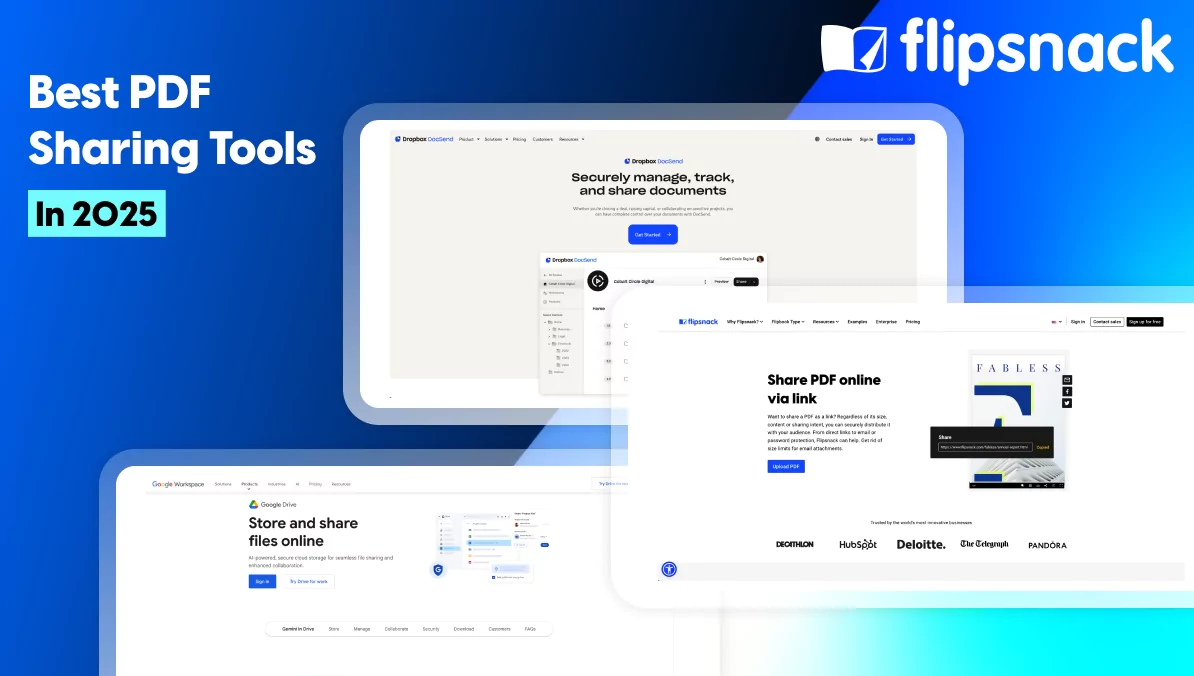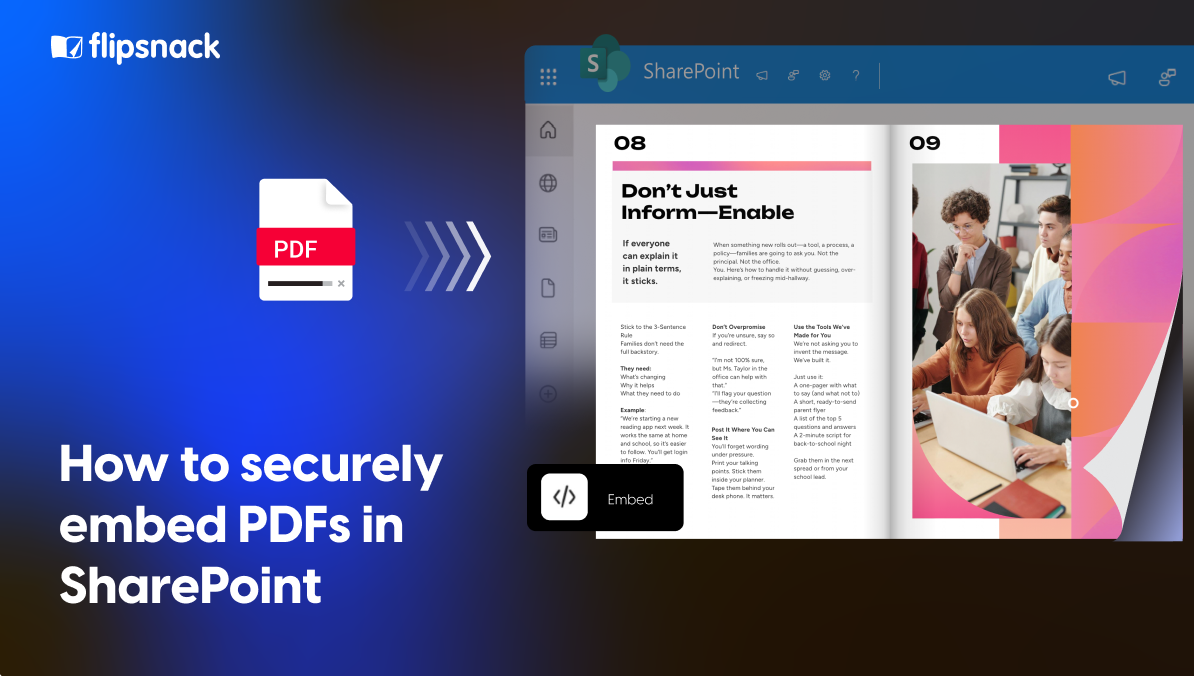3 Signs Your Approach to Internal Communication Is Hurting Security
A monthly employee newsletter or employee magazine for internal communication is a great tool to ensure that the company’s employees from several departments, divisions, or countries stay informed, excited about the company, and feel inspired. They need to be connected to the brand they are part of, right? And your newsletter will do just that.
As you gather the content you want to include, you’re eager to share it with your teams. You’re trying to put something exciting, engaging, and fun out there. For many, the go-to format is a PDF – a simple way to compile text and images.
But what if there was a better way, one that offers more engagement and, most importantly, more security?
There is. You can use a digital flipbook.
A flipbook is an interactive publication that transforms a static PDF into a dynamic, page-turning document that keeps people engaged for longer.
Flipsnack is a platform specializing in creating these secure, engaging digital flipbooks from your PDFs, helping with your internal communications.
You can share these flipbooks simply by sending a link accessible on any device. With rich media like videos, hyperlinks, quizzes, and forms, reading a corporate document becomes far more engaging than flipping through a flat PDF.
Why security matters in internal communication
While the focus is often on making content engaging, it’s easy to gloss over or bypass security considerations. That might not be the best approach, especially when sharing sensitive information.
Security is not just the job of the IT department; it’s the responsibility of every employee and every manager. Departments like HR and internal communications handle a lot of personal and confidential data, and they are responsible for protecting it.
Real world internal newsletter example
One of our clients, a tech company with over 500 employees across multiple countries, was preparing to launch an internal newsletter with Flipsnack. She had an upcoming meeting with her company’s security team to review the project.
Initially, she planned to downplay the security aspect by arguing that the newsletter content wasn’t “too confidential” and thus didn’t need heavy protection. We advised her to approach things differently.
In today’s world, assuming something “isn’t confidential” and skimping on security is a risky mindset.
Instead, she invited our team to join the security review meeting, and we were happy to walk through Flipsnack’s security features. The outcome? The security team approved, and the project moved forward with full confidence.
By involving security early and treating data protection as a priority, you avoid significant potential risks.
Now, let’s look at a few warning signs that your current approach to internal communication might actually be undermining security.

3 signs your approach to internal communication is hurting security
So what are some signs that your approach to internal communication could be hurting security?
1. You rely on PDFs and emails for sensitive information
Sharing information via PDF and email might seem convenient, but it can be dangerously uncontrolled. One customer put it bluntly:
“If I share this via PDF file… these people are free to share this PDF file with anybody, and they can actually post this on their social media. There are no limitations.”
Once a file leaves your system, you lose control over who sees it, how long they can access it, and whether it’s reshared externally. Even a password-protected PDF can be forwarded along with its password. This lack of control is especially risky when communicating with job candidates, contractors, or external partners.
But even with internal communication, there is an element of risk. The bigger the company, the greater the risk.
How Flipsnack helps
Instead of sending static PDFs as email attachments, Flipsnack lets you share content through secure, access-controlled links. Alisha VanTiem from Keywords Studios noted that eliminating bulky PDF email attachments and using flipbook links within the email dramatically improved their workflow:
The one general strategy that has shifted the HR team’s communications is the elimination of bulky email attachments, instead including links to our flipbooks within the body of the email.
Alisha VanTiem, Sr. Benefits Administrator
With Flipsnack, you maintain control over your documents even after sharing. For example, you can share an internal newsletter as a direct link (no more cumbersome downloads), then update that publication at any time. The link will always serve the latest version without the need to resend the files.
Additionally, Flipsnack provides several privacy features to ensure your content doesn’t fall into the wrong hands:
- Password protection: You can lock your flipbook behind a password, so only those with the correct password can view it. This creates a secure gateway for sensitive content.
- Private sharing: Restrict access to a specific list of email addresses. Only invited individuals can open the flipbook and access the private information.
- Unlisted visibility: Make your publication unlisted so it won’t be discoverable via search engines or public browsing. This adds another layer of privacy – people won’t stumble on your content without the direct link.
- One-time passcode via email: share private flipbooks with external readers using a unique passcode sent via email (no Flipsnack account required). Each time they access the document, a new one-time passcode is generated for increased security.
- Domain restriction: Control exactly where your flipbook can be embedded or viewed. For instance, you can authorize it to only display on your company’s intranet or a specific website. This prevents someone from taking the flipbook and embedding it on an unauthorized site.
By moving from email-attached PDFs to Flipsnack’s secure digital format, you gain the ability to control the way your content is shared.
2. Your IT team hasn’t signed off on communication tools
In many organizations, any new software tool – especially one used to handle internal information – must go through an IT or security review. This process is there for good reason. If your internal communications platform hasn’t been vetted by your company’s security or privacy experts, you could be exposing the organization to compliance risks, data leakage, or reputational damage.
It’s easy to fall in love with a tool’s features and skip this step, but doing so can hurt you in the long run.
Trust a platform that’s excited to go through IT security checks
Remember the story of our client above: she was enthusiastic about Flipsnack and initially wanted to minimize the “security talk” to push the project through. Our advice (and sincere belief) was to embrace the security review – in fact, we welcomed the opportunity to meet with her IT team. Why? Because we’re confident in our security measures, and we know that a thorough review will highlight Flipsnack’s strengths.
Whenever a client says, “I need our IT team to approve this first,” we see it as a positive sign. We often win deals when security is a key factor.
Just recently, another client told us their IT department found their previous way of sharing information unsafe (it lacked proper protections). Needless to say, Flipsnack passed their security/privacy review with flying colors, and we won that deal.
If your current approach to internal communication involves a tool or process that hasn’t been officially approved, you might be operating in a gray zone. Skipping the security vetting might save time upfront, but it can lead to serious issues later – from compliance violations to data breaches. No internal newsletter or platform is worth risking your company’s security policies. Beyond vetting tools, many teams lean on external expertise to strengthen policies and governance. Partnering with one of the best managed IT service providers can help you evaluate internal comms platforms against seven signs of excellence—such as all‑inclusive pricing, deep technical expertise, data security baked into services, vCISO guidance, and flexible, comprehensive support—so your rollout satisfies both usability and security.
How Flipsnack helps
Flipsnack is built with security from the ground up, which is why we’re happy to engage with your IT department. Our platform has all the enterprise-grade security assurances that reviewers look for. For example:
- Flipsnack’s security protocols are audited, verified, and kept up-to-date, complying with internationally recognized standards like ISO 27001 (information security management).
- We’re also fully GDPR compliant, offering the kind of data protection and privacy controls required by strict regulations.
- Flipsnack provides granular control over access and usage of content. Administrators of a workspace can assign roles and permissions to team members in the workspace, ensuring that only the right people can edit or publish sensitive documents
As Therese Lindeløv from Pandora noted:
Flipsnack helps us improve our internal digital communication. The features in Flipsnack make our collections and functionalities come alive and intriguing, helping us promote every level of detail and design concept, as well as material innovation to our store staff globally. From the beginning, Flipsnack has understood our priority of IT safety first, and their internal developers have worked to meet our high requirements.
Therese H. Lindelov, Creative Content Manager, Global Product
3. You don’t use secure access methods like SSO
The bigger the company, the higher the employee turnover and the more user accounts to manage. Handling access for dozens of tools manually is a headache – and a security nightmare – when people join or leave.
If you’re publishing an internal newsletter or report meant only for employees, you need a secure solution that is scalable, flexible, and easy to manage. Without Single Sign-On (SSO), you’d have to onboard and offboard users in your communication tool constantly.
Imagine 100 employees leaving in a month and 120 new ones joining; doing that by hand for your newsletter platform would be tedious and error-prone. Former employees might retain access longer than they should, and current employees might struggle with multiple passwords. All of this increases security risks.
SSO is the smarter way to manage access.
It means every user signs in with their standard company credentials (usually through an identity provider like Okta or Azure AD), and they automatically gain or lose access to approved tools based on their employment status. If your internal communications strategy lacks SSO or similar secure access controls – as well as related features like the ability to expire content or revoke access easily – then your approach might be leaving the door open for unauthorized access.
We’ve seen firsthand how much of a difference this makes. Flipsnack has often been praised for our security-first approach. One person even told us, “You guys have very good security. You should really talk about it more.”
So this is what we’re doing now.
We’re not shy about recommending Flipsnack as a solution because it is that good at security.
How Flipsnack helps
- Flipsnack supports Single Sign-On (SSO) integration, which significantly enhances security and simplifies user management. Employees can use their existing company login to access Flipsnack publications, eliminating the need for yet another username/password. This also reduces the risk of breaches – there are no weak, reused, or forgotten passwords specific to the newsletter to worry about. You can even choose to disable standard logins entirely and enforce SSO-only access, meaning only users authenticated through your company’s system can view the content. When someone leaves your organization and you deactivate their company account, their access to your Flipsnack publications is automatically removed as well.
- Additionally, you have the ability to enforce view-only access and prevent downloads or printing of your flipbooks. By restricting download options, you ensure employees can read the material but cannot save a copy to their device (which could be mis-shared later).
- And at any point, you retain the option to unpublish or remove a document from your Flipsnack account, instantly revoking access to content that was previously shared. In short, you maintain full control over your internal communications materials even after they’re distributed.
Conclusion
In summary, if your internal communication approach checks any of the boxes below, it’s probably not only inefficient but it’s also undermining your organization’s security policies and putting data at risk:
- Depends on unsecured formats like PDFs: Relying on static files and email attachments for internal news or documents.
- Bypasses IT/security review: Using tools or methods that haven’t been vetted and approved by your company’s security, privacy, or legal teams.
- Lacks modern access controls: No Single Sign-On (SSO), no expiration controls or audit trails, and inadequate management of who can access the content.
Any one of these is a red flag. The solution is to prioritize security in your internal communications strategy. Do your research before adopting new tools, ask vendors the hard questions, and always loop in your security department early in the process. By actively working with IT and security, you can find solutions that meet your needs and uphold your company’s security standards.
The good news is that you don’t have to sacrifice engagement or ease-of-use to get top-notch security. Platforms like Flipsnack are a prime example: you can have an interactive, engaging internal newsletter or report that employees love to read, while also satisfying the strictest security requirements. Keep security risks in check and make sure your internal communication tools are part of the solution – not a potential problem.
If you’re interested in exploring how Flipsnack can help you create a secure, interactive internal newsletter or report, we’re here to help. Feel free to reach out and get in touch with us to learn more about bringing your internal communications to the next level (safely and securely).




